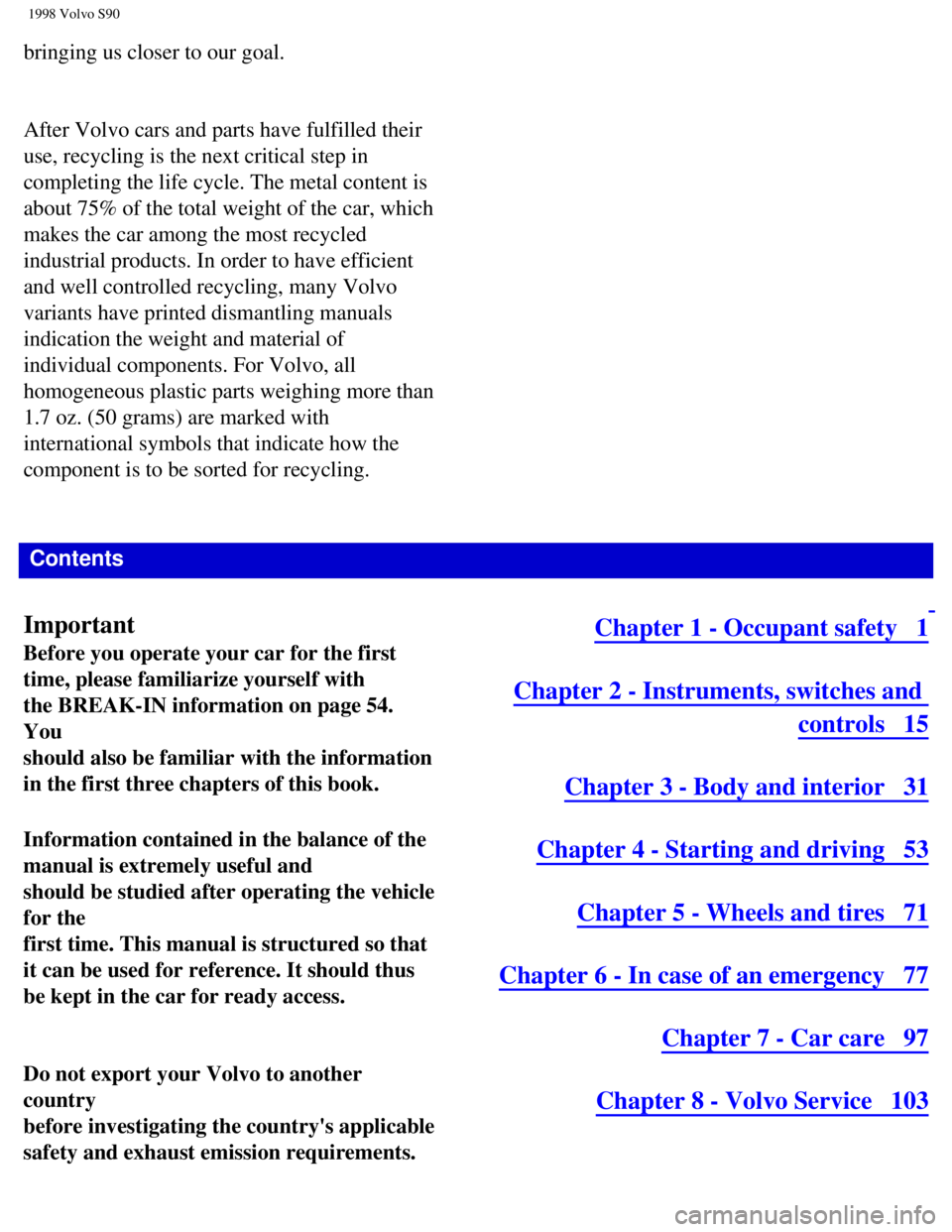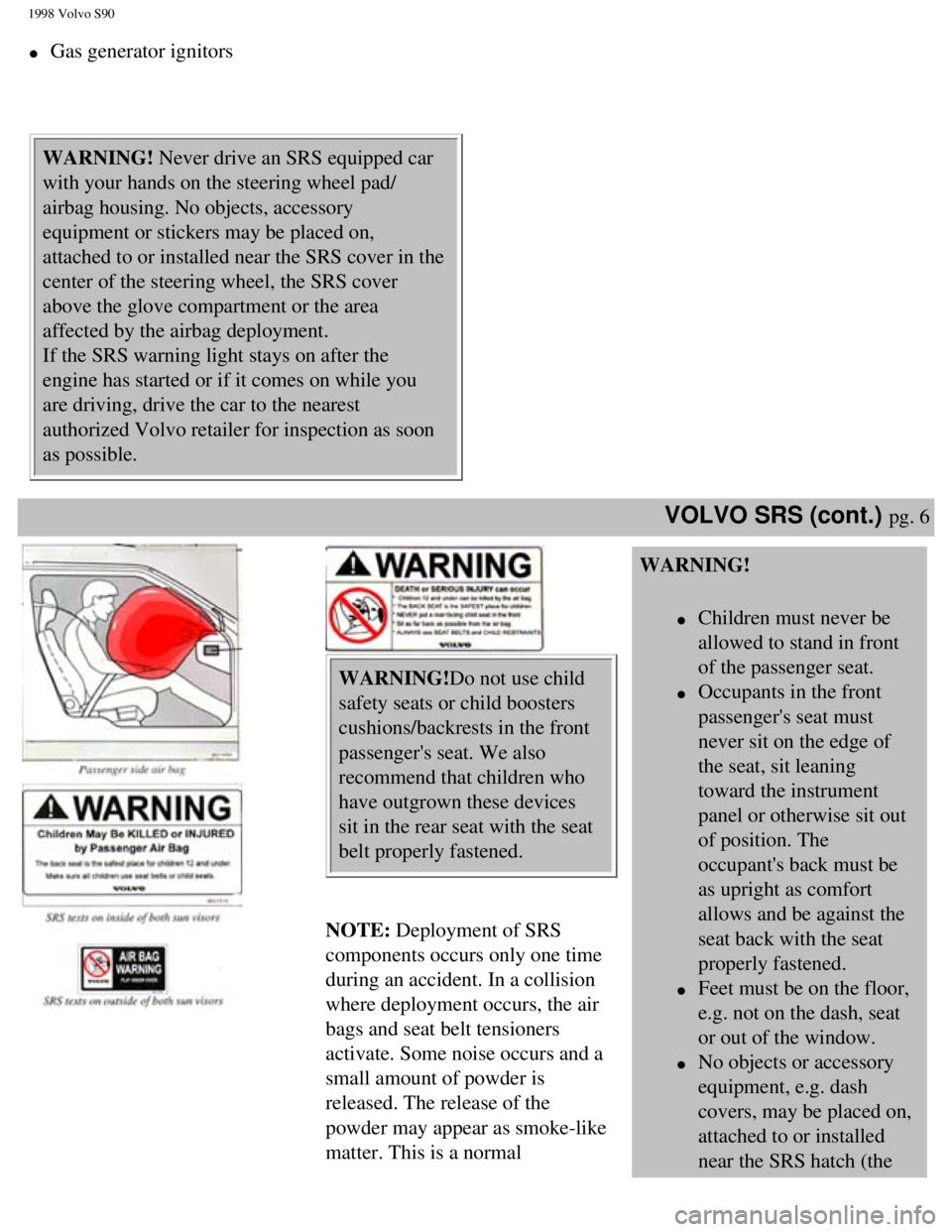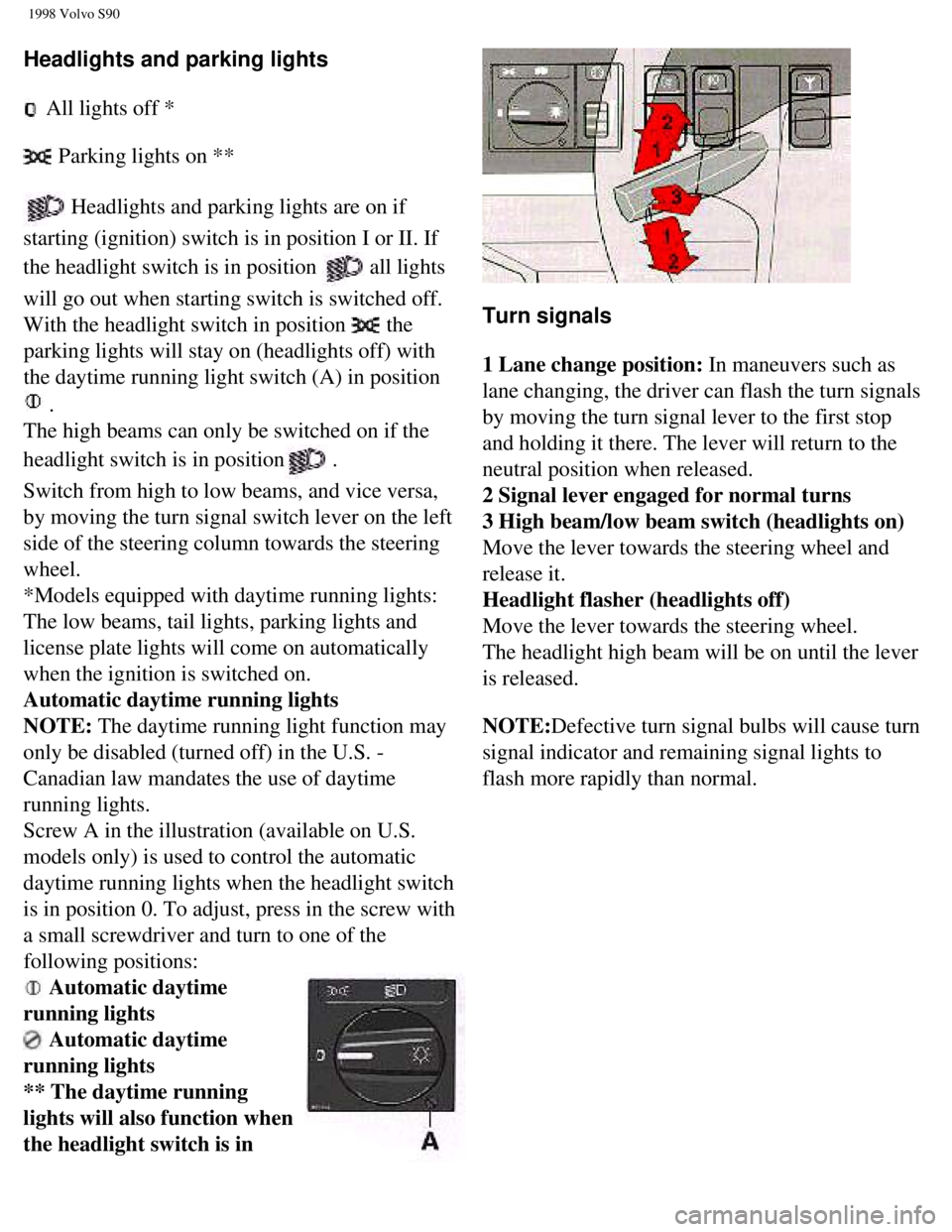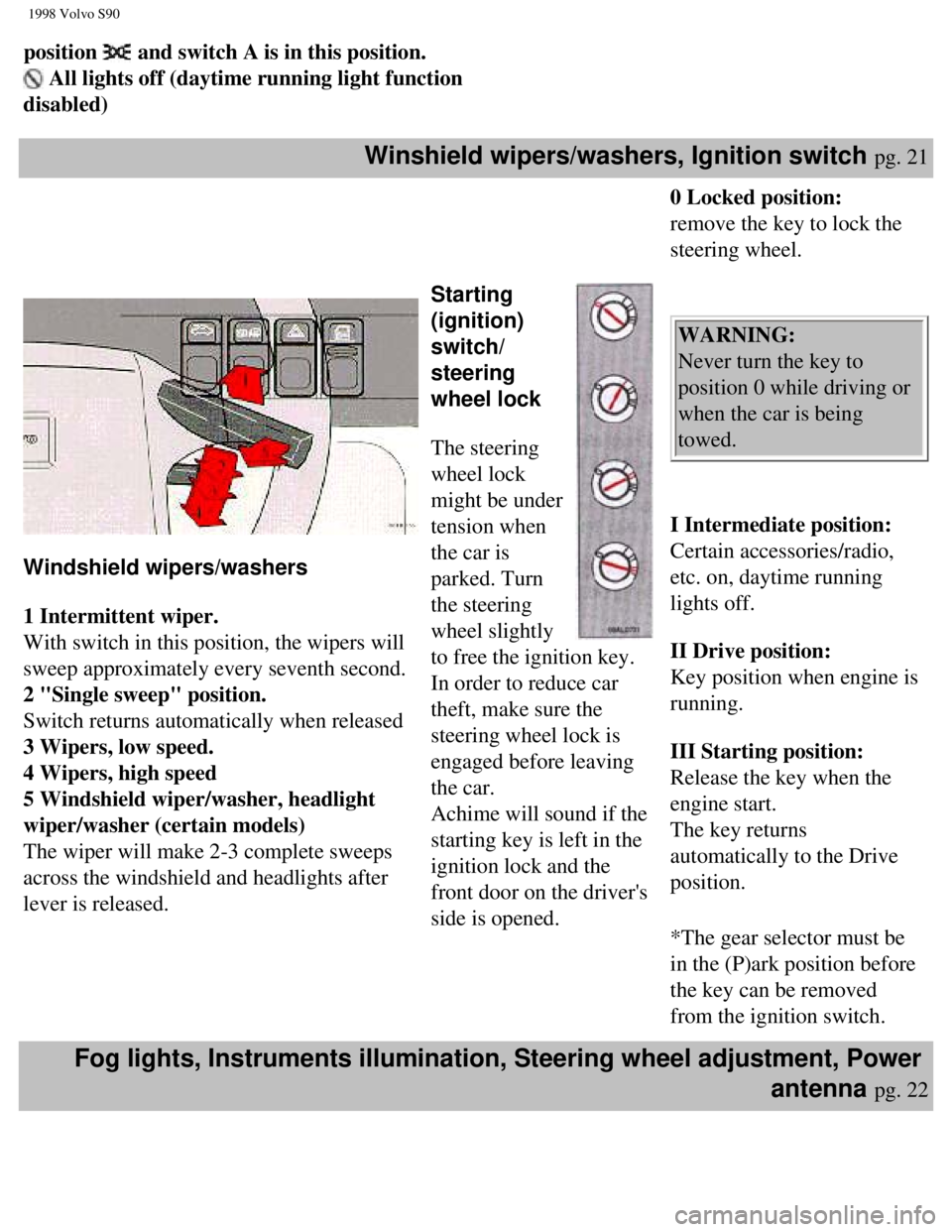1998 VOLVO V90 wheel
[x] Cancel search: wheelPage 1 of 175

1998 Volvo S90
VOLVO
S90 & V90
1998
This manual deals with the operation and care of your Volvo
Welcome to the worldwide family of Volvo
owners. We trust that you will enjoy many
years of safe driving in your Volvo, an
automobile designed with your safety and
comfort in mind. To help ensure your
satisfaction with this vehicle, we encourage
you to familiarize yourself with the equipment
descriptions, operating instructions and
maintenance requirements/recommendations
in this manual. We also urge you and your
passengers to wear seat belts at all times in this
(or any other) automobile. And, of course,
please do not operate a vehicle if you may be
affected by alcohol, medication or any
impairment that could hinder your ability to
drive. Your Volvo is designed to meet all applicable
safety and emission standards, as evidenced by
the certification labels attached to the driver's
door opening and on the left wheel housing in
the engine compartment.
For further information please contact your
retailer, or:
In the USA:
Volvo Cars of North America
Customer Support
P.O. Box 914
Rockleigh, New Jersey 07647-0914
800-458-1552
In Canada:
file:///K|/ownersdocs/1998/1998_SV90/98S90_000.htm (1 of 4)12/30/2006 \
1:52:33 PM
Page 3 of 175

1998 Volvo S90
bringing us closer to our goal.
After Volvo cars and parts have fulfilled their
use, recycling is the next critical step in
completing the life cycle. The metal content is
about 75% of the total weight of the car, which
makes the car among the most recycled
industrial products. In order to have efficient
and well controlled recycling, many Volvo
variants have printed dismantling manuals
indication the weight and material of
individual components. For Volvo, all
homogeneous plastic parts weighing more than
1.7 oz. (50 grams) are marked with
international symbols that indicate how the
component is to be sorted for recycling.
Contents
Important
Before you operate your car for the first
time, please familiarize yourself with
the BREAK-IN information on page 54.
You
should also be familiar with the information
in the first three chapters of this book.
Information contained in the balance of the
manual is extremely useful and
should be studied after operating the vehicle
for the
first time. This manual is structured so that
it can be used for reference. It should thus
be kept in the car for ready access.
Do not export your Volvo to another
country
before investigating the country's applicable
safety and exhaust emission requirements.
Chapter 1 - Occupant safety 1
Chapter 2 - Instruments, switches and
controls 15
Chapter 3 - Body and interior 31
Chapter 4 - Starting and driving 53
Chapter 5 - Wheels and tires 71
Chapter 6 - In case of an emergency 77
Chapter 7 - Car care 97
Chapter 8 - Volvo Service 103
file:///K|/ownersdocs/1998/1998_SV90/98S90_000.htm (3 of 4)12/30/2006 \
1:52:33 PM
Page 10 of 175

1998 Volvo S90
Chapter 1 - Occupant safety
VOLVO SRS
pg. 4
VOLVO SRS
As an enhancement to the three-point seat belt
system, your Volvo is equipped with a
Supplemental Restraint System (SRS). The Volvo
SRS consists of airbags (2) and knee bolsters (5)
on both the driver's and passenger's sides and seat
belt tensioners in both front door pillars (4). The
system is designed to supplement the protection
provided by the three-point seat belt system.
The SRS system is indicated by the "SRS"
embossed on the steering wheel pad and above
the glove compartment, the knee bolsters beneath
the steering column and the glove compartment
and decals on both sun visors and on the far right
side of the dash.
The airbags are folded and located in the center of
the steering wheel and above the glove
compartment. They are designed to deploy during
certain frontal or front-angular collisions,
impacts, or decelerations, depending on the crash
severity, angle, speed and object impacted. Both
airbags and seat belt tensioners will deploy, even
if the passenger seat is not occupied.
The airbag system includes gas generators (1)
surrounded by the airbags (2) and front seat belt
tensioners for both of the front seats (4). To deploy the
system, the sensor (3) activates the gas generators
causing the airbags to be inflated with nitrogen gas. As
the movement of the seats' occupants compresses the
airbags, some of the gas is expelled at a controlled rate
to provide better cushioning. Both seat belt tensioners
also deploy, minimizing any seat belt slack.
The entire process, including inflation and deflation of
the airbags, takes approximately two-tenths of a second.
WARNING!
When installing any optional equipment make sure
that the SRS system is not damaged. Do not attempt
to service any component of the SRS yourself.
Attempting to do so may result in serious personal
injury. If a problem arises, take your car to the
nearest authorized Volvo Retailer for inspection as
soon as possible.
file:///K|/ownersdocs/1998/1998_SV90/98S90_004.htm (1 of 7)12/30/2006 \
1:52:34 PM
Page 12 of 175

1998 Volvo S90
l Gas generator ignitors
WARNING! Never drive an SRS equipped car
with your hands on the steering wheel pad/
airbag housing. No objects, accessory
equipment or stickers may be placed on,
attached to or installed near the SRS cover in the
center of the steering wheel, the SRS cover
above the glove compartment or the area
affected by the airbag deployment.
If the SRS warning light stays on after the
engine has started or if it comes on while you
are driving, drive the car to the nearest
authorized Volvo retailer for inspection as soon
as possible.
VOLVO SRS (cont.) pg. 6
WARNING!Do not use child
safety seats or child boosters
cushions/backrests in the front
passenger's seat. We also
recommend that children who
have outgrown these devices
sit in the rear seat with the seat
belt properly fastened.
NOTE: Deployment of SRS
components occurs only one time
during an accident. In a collision
where deployment occurs, the air
bags and seat belt tensioners
activate. Some noise occurs and a
small amount of powder is
released. The release of the
powder may appear as smoke-like
matter. This is a normal
WARNING!
l Children must never be
allowed to stand in front
of the passenger seat.
l Occupants in the front
passenger's seat must
never sit on the edge of
the seat, sit leaning
toward the instrument
panel or otherwise sit out
of position. The
occupant's back must be
as upright as comfort
allows and be against the
seat back with the seat
properly fastened.
l Feet must be on the floor,
e.g. not on the dash, seat
or out of the window.
l No objects or accessory
equipment, e.g. dash
covers, may be placed on,
attached to or installed
near the SRS hatch (the
file:///K|/ownersdocs/1998/1998_SV90/98S90_004.htm (3 of 7)12/30/2006 \
1:52:34 PM
Page 13 of 175

1998 Volvo S90
characteristic and does not
indicate fire. area above the glove
compartment) or the area
affected by air bag
deployment (see
illustration).
l There should be no loose
articles, e.g. coffee cups,
on the floor, seat or dash
area.
l Never try to open the
SRS cover on the steering
wheel or the passenger
side SRS hatch. This
should only be done by
an authorized Volvo
service technician.
l Failure to follow these
instructions can result in
injury to the vehicle
occupants in an accident.
VOLVO SRS (cont.) pg. 7
NOTE:The information on this page does not pertain
to the Side Impact Protection System airbags.
When are the airbags deployed?
The SRS system is designed to deploy during certain
frontal or front-angular collisions, impacts, or
decelerations, depending in the crash severity, angle,
speed, and object impacted. The SRS sensor is
designed to react to both the impact of the collision
and the inertial forces generated by it and to
determine if the intensity of the collision is sufficient
for the airbags to be deployed.
WARNING! The SRS is designed to help prevent
serious injury. Deployment occurs very quickly
and with considerable force. During normal
deployment and depending on variables such as
seating position, one may experience abrasions,
bruises, swellings, or other injuries as a result of
airbag(s) deployment.
Seat belts - the heart of the Volvo safety
system
The heart of the Volvo safety system is the three-
point seat belt (a Volvo invention)! In order for the
SRS system to provide the protection intended, seat
belts must be worn at all times by everyone in the car.
The SRS system is a supplement to the seat belts.
WARNING! If your car has been subjected to
flood conditions (e.g. soaked carpeting/standing
water on the floor of the vehicle) or if your car has
become flood-damaged in any way, do not
attempt to start the vehicle or put the key in the
ignition before disconnecting the battery (see
below). This may cause airbag deployment which
could result in personal injury. Have the car towed
to an authorized Volvo retailer for repairs.
Automatic transmission only:
Before attempting to tow the car, use the
following procedure to override the shiftlock
file:///K|/ownersdocs/1998/1998_SV90/98S90_004.htm (4 of 7)12/30/2006 \
1:52:34 PM
Page 23 of 175

1998 Volvo S90
This means that when you switch off the ignition,
the gear selector must be in the (P)ark position
before the starting (ignition) key can be removed
from the ignition switch.
Anti-Lock Brake System (ABS)
The ABS system in your car performs a self-
diagnostic test when the vehicle is started and at
4 mph (6km/h). The driver may detect one
pulsation of the brake pedal and a sound will be
audible from the ABS control module. This is
normal.
The pages in this section provide detailed
descriptions of the vehicle's instruments and
controls.
Note that vehicles may be equipped differently,
depending on special legal requirements. 16 Controls for electrically operated windows...
pg. 29
and side-view mirrors...pg. 35
17
Instrument illumination...pg. 22
18
Hood-release handle...pg. 39
19
Turn signals, high/low beams...pg. 20
cruise control...pg. 24
20
Adjustable steering wheel...pg. 22
21
SRS (air bag)/Horn...pg. 4
22
Starting (ignition) switch/steering wheel
lock...pg. 21
23
Windshield wiper/washer...pg. 21
Tailgate wiper/washer (wagons)...pg. 23
24
Cigarette lighter...pg. 30
25
Transmission mode selector buttons...pg. 59
26
Gear selector...pg. 58
27
Ash tray...pg. 30
28
Shiftlock release (override) button...pg. 61
29
Parking brake...pg. 30
30
Electrically-heated front seats (certain
models)...pg. 28
Instruments pg. 16
file:///K|/ownersdocs/1998/1998_SV90/98S90_014.htm (2 of 3)12/30/2006 \
1:52:36 PM
Page 28 of 175

1998 Volvo S90
Headlights and parking lights
All lights off *
Parking lights on **
Headlights and parking lights are on if
starting (ignition) switch is in position I or II. If
the headlight switch is in position
all lights
will go out when starting switch is switched off.
With the headlight switch in position
the
parking lights will stay on (headlights off) with
the daytime running light switch (A) in position
.
The high beams can only be switched on if the
headlight switch is in position
.
Switch from high to low beams, and vice versa,
by moving the turn signal switch lever on the left
side of the steering column towards the steering
wheel.
*Models equipped with daytime running lights:
The low beams, tail lights, parking lights and
license plate lights will come on automatically
when the ignition is switched on.
Automatic daytime running lights
NOTE: The daytime running light function may
only be disabled (turned off) in the U.S. -
Canadian law mandates the use of daytime
running lights.
Screw A in the illustration (available on U.S.
models only) is used to control the automatic
daytime running lights when the headlight switch
is in position 0. To adjust, press in the screw with
a small screwdriver and turn to one of the
following positions:
Automatic daytime
running lights
Automatic daytime
running lights
** The daytime running
lights will also function when
the headlight switch is in
Turn signals
1 Lane change position: In maneuvers such as
lane changing, the driver can flash the turn signals
by moving the turn signal lever to the first stop
and holding it there. The lever will return to the
neutral position when released.
2 Signal lever engaged for normal turns
3 High beam/low beam switch (headlights on)
Move the lever towards the steering wheel and
release it.
Headlight flasher (headlights off)
Move the lever towards the steering wheel.
The headlight high beam will be on until the lever
is released.
NOTE:Defective turn signal bulbs will cause turn
signal indicator and remaining signal lights to
flash more rapidly than normal.
file:///K|/ownersdocs/1998/1998_SV90/98S90_017.htm (4 of 7)12/30/2006 \
1:52:36 PM
Page 29 of 175

1998 Volvo S90
position and switch A is in this position.
All lights off (daytime running light function
disabled)
Winshield wipers/washers, Ignition switch pg. 21
Windshield wipers/washers
1 Intermittent wiper.
With switch in this position, the wipers will
sweep approximately every seventh second.
2 "Single sweep" position.
Switch returns automatically when released
3 Wipers, low speed.
4 Wipers, high speed
5 Windshield wiper/washer, headlight
wiper/washer (certain models)
The wiper will make 2-3 complete sweeps
across the windshield and headlights after
lever is released.
Starting
(ignition)
switch/
steering
wheel lock
The steering
wheel lock
might be under
tension when
the car is
parked. Turn
the steering
wheel slightly
to free the ignition key.
In order to reduce car
theft, make sure the
steering wheel lock is
engaged before leaving
the car.
Achime will sound if the
starting key is left in the
ignition lock and the
front door on the driver's
side is opened. 0 Locked position:
remove the key to lock the
steering wheel.
WARNING:
Never turn the key to
position 0 while driving or
when the car is being
towed.
I Intermediate position:
Certain accessories/radio,
etc. on, daytime running
lights off.
II Drive position:
Key position when engine is
running.
III Starting position:
Release the key when the
engine start.
The key returns
automatically to the Drive
position.
*The gear selector must be
in the (P)ark position before
the key can be removed
from the ignition switch.
Fog lights, Instruments illumination, Steering wheel adjustment, Power antenna
pg. 22
file:///K|/ownersdocs/1998/1998_SV90/98S90_017.htm (5 of 7)12/30/2006 \
1:52:36 PM